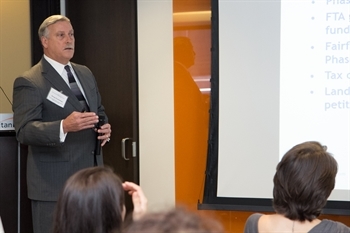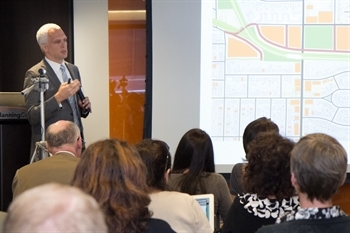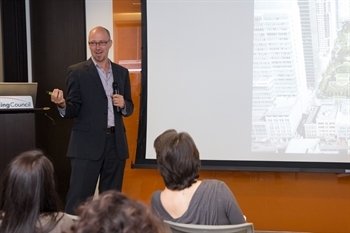
From left, Gabriel Metcalf, Ryan Gravel, Doug Koelemay
Did you miss the roundtable? View the webcast.
Despite the slow pace of economic recovery, metropolitan Chicago’s growing population is demanding smarter investments to expand and improve transportation options and create more quality housing near jobs and transit. Given the scarcity of public funds available to make even the most essential infrastructure investments, governments have begun to use value capture financing tools to supplement traditional funding sources.
What is value capture?
Because well-planned public transportation investments improve people’s access to desirable destinations, land near these investments commands higher prices, benefiting property owners and developers. Value capture is a type of public financing through which increases in private land values generated by public transportation investments are “captured” to repay the cost of the public investment. Value capture mechanisms such as tax increment financing, special assessments and impact fees connect the benefit of an investment with the cost to provide it, allowing the public and private sectors to share rewards created beyond the original project.
At the Metropolitan Planning Council’s September roundtable, “Getting Our Money’s Worth: Using Value Capture to Fund Transit,” we explored how San Francisco, Atlanta, Ga., and Tysons Corner, Va., outside of Washington, D.C., are using value capture to generate revenue to finance transit improvements that can – and in some cases already are – transforming communities. These three projects resonated particularly well with our Chicago audience, in part because they feature investments that are being or could be replicated in our own region, such as Bus Rapid Transit and upgrades to Chicago Union Station.

Eric Hirschfield, Goldman Sachs
Eric Hirschfield of Goldman Sachs kicked off the roundtable, saying the afternoon was an opportunityto re-think how the Chicago region invests in the public transit our population is demanding, in the face of declining traditional revenue sources such as the gas tax. For example, transit ridership in Chicago is growing: Recorded rides on the CTA’s rail system rose 6.2 percent during the first half of 2012, the 51st consecutive monthly increase. With several large capital investment projects planned, like the Red and Purple Line modernization project and the potential for a new Bus Rapid Transit route to serve the Western and Ashland corridors, this trend will continue. Hirschfield advised that given the scarcity of available public funds, it’s up to states, cities, and regions to think differently about how to fund transportation projects.
Case Study: Metrorail Expansion to Dulles Airport
Doug Koelemay, vice president of community relations at Science Applications International Corporation (SAIC), spoke about how business owners in Tysons Corner are doing just that to help fund the$5.2 billion, 23-mile extension of the existing Metrorail to Tysons Corner and Dulles Airport. Doug brought an important private sector perspective to the discussion stressing that land owners bought into the idea to tax themselves to help fund the rail line due to key provisions in the tax district agreement: There was a cap on total district tax receipts, not to exceed $400 million, which brought certainty to private sector finance planning and that local government agreed to fund any capital cost increase and refund the special assessment dollars if federal dollars did not materialize. The Phase I Special Assessment District produced project revenues for almost six year before initial project outlays were necessary, as such, the assessment of 22 cent per $100 of assessed value will decrease beginning in 2013.

Doug Koelemay, SAIC
Koelemay also explained that the three large landowners in Tysons Corner jumpstarted the special assessment district, because they realized if Tysons wanted to compete with other developing areas, it needed reliable transit service. These land owners completed an initial cost-benefit analysis and provided seed money for advocacy to gain support.
The positive effects of the Phase I Special Assessment District provided a model for the subsequent Phase II Special Assessment District formed by Fairfax County and Loudoun County to fund $330 million of the project’s second phase. Further, Fairfax County is now considering a new transportation improvement district to support other Tysons Corner transportation investments as the Phase I district for Metrorail expires. Koelemay said value capture is a great tool that aligns the investment mindedness of the private and public sector. As a result of its success and given the scarcity of public dollars, Northern Virginia now clearly understands that value capture is an essential tool in providing transportation improvements that complement land use decisions.
Case Study: The Atlanta BeltLine
Ryan Gravel, senior urban designer for Perkins + Will, kicked off the Atlanta BeltLine discussion with the following statement: “Developing new solutions to the problems created by a sprawl-dominated landscape will require a new thinking, and ultimately, a new kind of city. The BeltLine will change the way we think about Atlanta.”

Ryan Gravel, Perkins + Will
The Atlanta BeltLine, the brain child of Gravel’s, is the most ambitious public works project in the city’s history. The $2.8 billion project in Atlanta’s urban core will build 22-miles of transit through 45 neighborhoods, a 33-mile network of multi-use trails, nearly 1,300 acres of new parks and green space, and more than 5,600 new units of affordable workforce housing. $1.7 billion of the $2.8 billion project costs are funded with a 25-year Tax Allocation District (TAD), which operates the same way as tax increment finance (TIF) district.
Gravel stressed it takes a partnership to accomplish and fund such a transformative project. In 1999, after he published his joint master’s thesis that was the original vision for the BeltLine, a grass roots movement to make it a reality took shape. By 2005 The Atlanta BeltLine Partnership was formed with the City of Atlanta and, as part of the redevelopment plan, the 6,500 acre BeltLine TAD instituted with buy in from the City, Fulton County, and Atlanta Public Schools. As part of the Community Engagement Framework authorized by the BeltLine legislation, the Tax Allocation District Advisory Committee (TADAC) was created to advise on how TAD funds are used. This committee is comprised of technical experts and community leaders.
Case Study: San Francisco’s Transbay Transit Center
San Francisco has embarked on one of the nation’s largest transit infrastructure projects, the renovation of the downtown Transbay Terminal. The new Transbay Transit Center will create a modern, multimodal transportation hub that will centralize the Bay Area’s 11 transit systems to accommodate more than 100,000 passengers each weekday and anchor a new transit-friendly neighborhood just south of San Francisco’s Financial District, including a 5.4 acre rooftop park and a 1,000-foot-tall office tower that will become the city’s tallest building.

Gabriel Metcalf, SPUR
Gabriel Metcalf, executive director of the San Francisco Planning and Urban Research Association (SPUR) described how San Francisco is layering several financing tools; including tax increment financing, a special assessment, development impact fees, and a federal Transportation Infrastructure Finance and Innovation Act (TIFIA) loan, to finance the $4 billion Transbay Transit Center. Metcalf explained the redevelopment will be partially funded with a Mello-Roos or an additional special assessment tax on property of 0.35 percent for new development that will generate $250 million. Development impact fees ranging from $5 to $35 per square foot of new development in the plan area will fund another $125 million. State owned land sales will bring in $600 million and tax increment financing $1.2 billion. Thus far, $548 million in federal Transportation Infrastructure Finance and Innovation Act loans have been secured that, that will be repaid with tax increment financing (TIF) from land sold and development in the surrounding state owned parcels.
Two cautionary notes of advice from Metcalf: Timing is important in locking in a TIF district because the public announcement of a new transit investment immediately impacts land values and that there is not always land value to recapture due to development costs.
Metcalf also highlighted that parking meter revenue in San Francisco funds public transit, to the tune of $300 million of the $800 million budget. This makes sense because the SFpark program, a demand based parking system, increases meter fees based on occupancy, so as rates go up in popular areas, people gravitate to public transit.
More on Value Capture